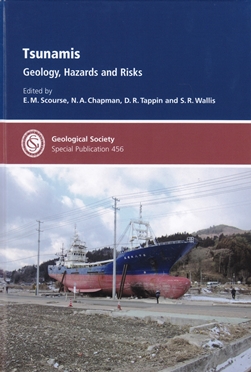 Tsunamis: Geology, Hazards and Risks
Tsunamis: Geology, Hazards and Risks
This book in the Society’s Special Publication series discusses a variety of topics from reviewing tsunami hazards globally to risk modelling. The first four sections are entirely focused on the 2011 Tohoku earthquake and the subsequent tsunami that was responsible for so much damage. Other papers examine the history of tsunami activity in locations such as Central America.
The collection is divided up into two categories: 1: tsunami hazards globally, which demonstrates the worldwide effect of tsunami activity; and 2: risk modelling, which evaluates the likelihood of tsunami hazards nationally (New Zealand is of particular focus here) and internationally. A personal and unexpected highlight was a paper discussing tsunamis that had affected the UK; a unique catalogue of events recorded through observations, tidal gauges and sedimentological deposits. As a bit of an eye opener, I was interested to learn about a list of probable tsunami events in the UK which date back as far as 1762.
Although teaching takes you a certain distance with geological topics this book expands on tsunami knowledge nicely, cutting out the chit-chat and delving straight into the scientific terminology, and assuming that the reader already has a grasp of how tsunamis function. Readers from such backgrounds as humanitarian/hazard response may find this a little jarring; however, the reader is eased in gently by the smooth writing of the articles.
As an undergraduate, I found most of the text easy to follow; the accompanying figures support the articles well. The content of papers appeals to many backgrounds due to a wide range of disciplines discussed - from geophysics to sedimentology and with a fair amount of interesting background history. On the whole, someone with basic geological knowledge should have little trouble making their way through the literature and interpreting the diagrams.
I would recommend this as an insightful read to someone who already takes an interest in the geological and historical aspects of tsunamis, whether they a student wishing to supplement their course, or an experienced academic. The quality of the papers is fairly consistent, each offering original data, analysis and interpretations.
This publication brings together many unique aspects of tsunami research to create a refreshing collection that will be of interest to readers from geoscientific, technical, engineering, humanitarian and hazard related backgrounds.
Reviewed by Emma Smith
TSUNAMIS: GEOLOGY, HAZARDS AND RISKS by E M SCOURSE N A CHAPMAN, D R TAPPIN & S R WALLIS, 2018. Published by: Geological Society of London 252pp (hbk) ISBN: 9781786203182 List Price: £90.00 Fellows’ Price: £45.00. W: www.geolsoc.org.uk/SP456
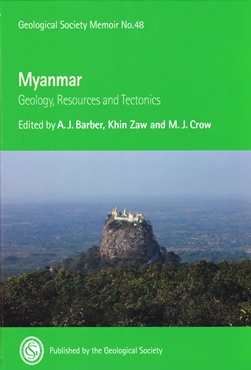 Myanmar Geology, Resources and Tectonics
Myanmar Geology, Resources and Tectonics
Myanmar Geology, Resources and Tectonics, Geological Society Memoir No. 48 is made up of 31 chapters and an appendix on geochronology. Each chapter is a stand-alone paper that has been assimilated into a single volume covering three related topics. Details of some of the papers present an easy-to-follow description of the tectonic setting of different mining areas throughout most the country. The introduction to the volume has a general description of some of the major mining organizations that have worked in Myanmar since the Chinese started silver mining at the Bawdwin mine site in the 15th Century. Myanmar’s location and geologic evolution with respect to India, Eurasia, China, Thailand, Laos, Sumatra and the Andaman Sea from the Paleozoic to the present is discussed.
The authors note that, due to current internal conditions, not all of Myanmar is thoroughly discussed in the volume, or fully explored for mineral resources. For what is included and covered, an overview of the local geologic setting relationship between the ores and gemstones with respect to the local and regional geology is well presented. In several places the authors discuss the relationships between different ores and ophiolites, faulting, as well as granites and limestones or sandstones. In several cases, samples of selected mines are discussed in enough detail to allow the reader to obtain a picture of the geologic setting at the mines, including how much ore had been removed, when data was available.
Overall, I found the volume to be an outstanding general reference for the geology, resources and tectonic description of Myanmar, including adjacent offshore areas. A suggested improvement would be a map depicting all the major mines and placer deposits for the metals and gemstones on one sheet, as a supplement to the volume. In addition, the discussion of coal oil and gas resources is a little short and could be expanded. That said, I highly recommend this volume for anyone interested in the geology, resources and tectonics of Myanmar. The volume should be reviewed as a benchmark by anyone considering preparing a similar volume in another country or region.
Reviewed by Robert Anderson
MYANMAR GEOLOGY, RESOURCES AND TECTONICS edited by A.J. BARBER, K. ZAW AND M. J. CROW 2017 Published by The Geological Society, London, Memoir 48, ISBN: 978-1-86239-969-3 List Price: £ 160 Fellows Price: 80.00 W: www.geolsoc.org.uk/M0048
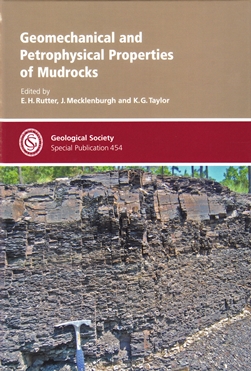 Geomechanical and Petrophysical Properties of Mudrocks
Geomechanical and Petrophysical Properties of Mudrocks
The geomechanical and petrophysical properties of mudrocks have become a topic du jour recently, mainly due to the gas shale energy boom. Such properties are also critical for conventional petroleum exploration and production in terms of top seal integrity, wellbore stability and pore pressure prediction for example, as well as for geological CO2 storage and nuclear waste disposal. Characterisation of mudrocks as reservoirs and/or seals requires specialised knowledge and testing equipment due to the response of clay-bearing materials to changes in saturation, fluid composition, effective stress and microstructure. Most sealing mudrocks are rich in clay minerals with small pore throat sizes and high ductility, while the so called gas shales tend to be rich in organic matter and low in clay, allowing them to better sustain natural and induced fracture systems.
This GSL special publication stems from an eponymous conference in 2015. There are a number of high quality papers researching laboratory properties of these materials with a couple more focusing on modelling. There is little in the volume however investigating these properties at a larger scale and ‘petrophysics’ as used here is a misnomer for physical properties (e.g. porosity and permeability) rather than traditional petrophysical log evaluation. As this volume came into being from a conference, this is likely a reflection of submitted content, and does not detract from the extensive laboratory-based research presented.
The volume is divided into three sections, the first covering petrophysical properties comprising seven papers, the second part covers microstructure and mineralogy with five papers along with a third section on fractures with three papers. There is a relatively even split between water saturated over/underburden mudrocks and gas shales. Determinations of porosity and permeability in mudrocks feature strongly, with links made to the impact of stress and microstructure, the latter in the main having SEM images of high quality. Lithology and pore structure effects are also covered, with impacts in areas ranging from engineering geology to shale reservoirs. The section on fracturing covers laboratory experiments, field scale seismicity and hydraulic fracture modelling, generally applicable to shale reservoirs.
The papers are well set out, the vast majority of the diagrams are clearly visible and easy to read with the liberal use of colour throughout a bonus. This book would be a good read for specialists working on mudrocks for various applications and also for people wanting to know more about the topic as the reference lists throughout are very comprehensive.
Reviewed by David Dewhurst
GEOMECHANICAL AND PETROPHYSICAL PROPERTIES OF MUDROCKS, by RUTTER E.H., MECKLENBURGH, J, & TAYLOR, K.G. (editors). Geological Society of London Special Publication No 454. 2017. Geological Society of London. ISBN 978-1-78620-316-8. Hbk. 368pp. ISSN 0305-8719. List Price: £120. Fellows' Price: £60.00. W: www.geolsoc.org.uk/SP454
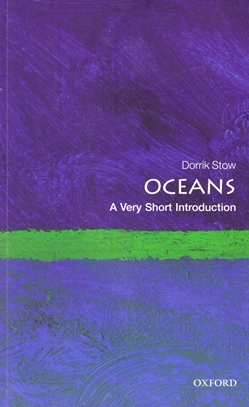 Oceans: A Very Short Introduction
Oceans: A Very Short Introduction
This pocket-size book condenses a lot of information into 150 or so pages. The author is oceanographer and sedimentologist Dorrik Stow, professor at Heriot Watt University and publisher of over 250 research papers. In keeping with the idea behind OUP’s long-running ‘A Very Short Introduction’ series, the text is clean and clear. Most of the precise, technical words that decorate geological literature have been replaced by simpler words or phrases. Importantly, this makes the book available to a far wider audience. I found it an interesting, but worrisome, read.
Oceans cover 71% of our planet; and we still know very little about them. Over the past 50 years, scientists have been gathering information at an ever increasing rate, and now know enough to indicate the presence of quite a few deposits we might choose to exploit.
In some areas, vast fields of a frozen mix of methane and ice lie only metres below the seabed. Manganese nodules found on the deep sea floor are not yet viable for their manganese alone, but may prove viable as the source of a ‘pot pourri’ of metals including copper, nickel and cobalt, as well as minor amounts of zinc, lead, vanadium and molybdenum along with the manganese. Narrow, elongate, deposits of metal-rich muds have been found beneath hot brine pools. Some of them are potentially mineable for lead, copper, zinc, and silver. Hydrothermal vents, found along the crest of the mid-ocean ridge system, sometimes form chimneys of condensed metal sulphides, comparable in mineral content to the largest metal sulphide deposits mined on land.
Of course, underwater drilling is not new, but as shallow deposits are exhausted we are drilling deeper. Stow tells us that, in the last decade, over 50% of oil and gas discoveries have been in the ocean deeps. Rigs routinely drill to depths of 2500 metres.
Add these factors to the already worrying issues of ocean plastic, coral reef bleaching, and global warming, and the situation could move rapidly from bad to worse. This book needs promoting and updating annually.
Reviewed by David Edwards
OCEANS: A VERY SHORT INTRODUCTION by DORRIK STOW. Oxford UP 2017. 216pp, sbk. List price: £7.99. W: https://global.oup.com/academic/product/oceans-a-very-short-introduction-9780199655076?cc=gb&lang=en&
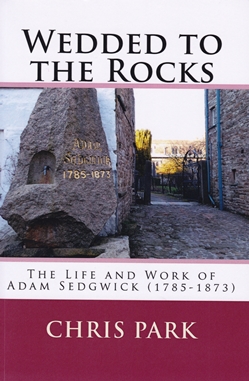 Wedded to the Rocks: The Life and Work of Adam Sedgwick
Wedded to the Rocks: The Life and Work of Adam Sedgwick
Timed to coincide with the bicentenary of Adam Sedgwick’s election to the Woodwardian professorship, Chris Park’s Wedded to the Rocks is an eminently readable introduction to the life and work of one of the most famous geologists of the mid-19th Century.
Son of a Cambridge educated vicar, born and bred in Dent, Cumbria, Adam Sedgwick rose through the ‘ranks’ of Trinity College Cambridge to become a Fellow in 1810 and tried to settle into teaching mathematics. However, when the Woodwardian professorship fell vacant in 1818 and despite knowing little geology, Sedgwick thought that the profession of geology would improve his health and provide an opportunity for intellectual advance in a way that teaching mathematics would not. Although, poorly remunerated at 100 pounds a year and with a prerequisite of bachelordom or ‘domestic sterility’, as Sedgwick called it, he applied and was elected.
Park ably shows how Sedgwick did indeed become ‘Wedded to the Rocks’ and used his 55 year-long tenure of the Woodwardian chair to transform the study of geology in Cambridge and build a major collection of geological materials, now housed in the Sedgwick Museum, which was opened as a memorial to him in 1904.
From 1890, the main source of information on Sedgwick’s life and work has been the Clark and McKenny Hughes monumental two-volume ‘Life and Letters etc.’. Being Sedgwick’s successor as Woodwardian professor, Hughes wrote a rather uncritical work designed to rescue of Sedgwick’s geological reputation and especially his work on the Cambrian, which had been all but obliterated from the record by his erstwhile collaborator Murchison.
Since then, the most notable popular account has been Speakman’s 1982 ‘Adam Sedgwick: Geologist and Dalesman’, which gave new information about Sedgwick’s upbringing in the Dales. Long out of print, this useful little book is now republished by the Yorkshire Geological Society and Gritstone Writers Co-operative Ltd (145p. ISBN 9780995560949).
More recently, several historians of science have discussed Sedgwick and his work in various different contexts. And while Park uses many of these sources, ‘Wedded to the Rocks’ follows a fairly traditional chronological approach. This focuses successively on Sedgwick the Dalesman, Cambridge man, the Geologist, Churchman and old man, which is ideal for readers wanting a readable and not overly academic account.
Although Sedgwick was a major contributor to the development of British geology in the early decades of the 19th Century he did not perhaps contribute as much as he could have. He was always promising to write a major work on the Palaeozoic geology of Britain but never managed to do so.
Reviewed by Douglas Palmer
WEDDED TO THE ROCKS: THE LIFE AND WORK OF ADAM SEDGWICK (1785-1873) by CHRIS PARK, 2017. Published by Chris Park, 329p (pbk) ISBN 9781548851705. List price £7.50, available from W: www.amazon.co.uk.
 Conservation Paleobiology: Science and Practice
Conservation Paleobiology: Science and Practice
For centuries it was axiomatic that understanding the present is key to understanding the geological past. Geoscientists have awakened, however, to the realisation that mankind has had an enormous effect on the present, whole ecosystems being impacted during at least historical times. Conservation ecologists have likewise realised that their own work is severely challenged by anthropogenic impacts. Modern ecosystems, on which ecologists and palaeoecologists alike have long modelled their work, are under great and unique stresses due to anthropogenic pressures. Habitats are being destroyed and climates are changing rapidly. How, then, should conservationists respond to such pressures? How can they maintain ecosystems while changing abiotic pressures (water supply, temperature) are affecting those ecosystems? What should the conserved or restored ecosystems look like? And how might palaeoecologists contribute to this work?
Conservation palaeobiology can assist by determining the past nature of present ecosystems, and so ascertaining what their normal state should be. This subject matter is the crux of this book, an expanded reprint of the proceedings of a short course titled Conservation Biology, Using the Past to Manage the Future. Given that 24 of the 26 authors are from the USA, a North American bias is to be expected. Nevertheless, the authors do an interesting job of assessing different ecosystems (terrestrial, aquatic, marine) at different time scales. They use geochemical, body and trace fossil evidence to suggest how we might use knowledge of ancient ecosystems and their food webs to manage and preserve present day ones. They also address the issue as to whether past ecosystem states are suited to our modern and changing climate.
This book abounds with case studies. Smol argues that we should assess what aquatic nutrient levels were prior to European style agriculture, and aim to restore such levels. He implicitly assumes that the First Nations people had no impact. Conversely, Jackson and McClenachan argue that historical records are too short, pre-Columbian humans having impacted marine tetrapod, fish and mobile invertebrate faunas. The subject of Pleistocene rewilding – the need to look back at the last interglacial – is addressed, as is the impact of the loss of megafauna on such projects. Near natural habitats existing only in isolated national parks, the authors discuss assisting migration between them. The fossil record is used to suggest what should be moved where, and at what rate. The final chapter is an informative round-table discussion. This fascinating book is a must read for all involved with palaeobiology, ecology and environmental management.
Reviewed by Brent Wilson
CONSERVATION PALEOBIOLOGY: SCIENCE AND PRACTICE, by DIETL, G. P. AND FLESSA, K. W. (Eds), 316 p. Published by The University of Chicago Press, ISBN 978-0-226-50672-2, £30.00. W: http://press.uchicago.edu/ucp/books/book/chicago/C/bo27210698.html